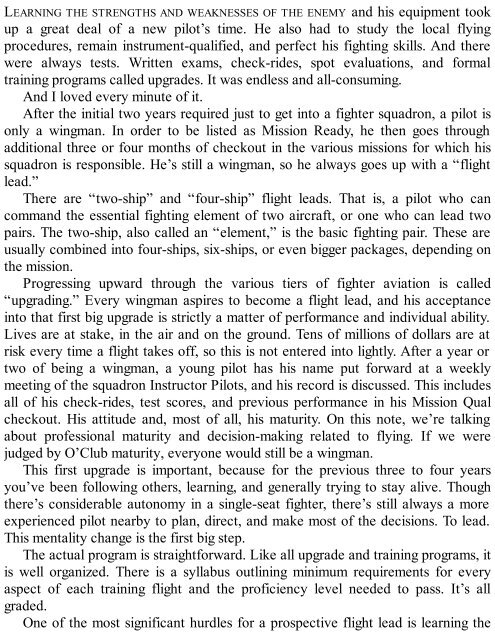Create successful ePaper yourself
Turn your PDF publications into a flip-book with our unique Google optimized e-Paper software.
LEARNING THE STRENGTHS AND WEAKNESSES OF THE ENEMY and his equipment took<br />
up a great deal of a new pilot’s time. He also had to study the local flying<br />
procedures, remain instrument-qualified, and perfect his fighting skills. And there<br />
were always tests. Written exams, check-rides, spot evaluations, and formal<br />
training programs called upgrades. It was endless and all-consuming.<br />
And I loved every minute of it.<br />
After the initial two years required just to get into a fighter squadron, a pilot is<br />
only a wingman. In order to be listed as Mission Ready, he then goes through<br />
additional three or four months of checkout in the various missions for which his<br />
squadron is responsible. He’s still a wingman, so he always goes up with a “flight<br />
lead.”<br />
There are “two-ship” and “four-ship” flight leads. That is, a pilot who can<br />
command the essential fighting element of two aircraft, or one who can lead two<br />
pairs. The two-ship, also called an “element,” is the basic fighting pair. These are<br />
usually combined into four-ships, six-ships, or even bigger packages, depending on<br />
the mission.<br />
Progressing upward through the various tiers of fighter aviation is called<br />
“upgrading.” Every wingman aspires to become a flight lead, and his acceptance<br />
into that first big upgrade is strictly a matter of performance and individual ability.<br />
Lives are at stake, in the air and on the ground. Tens of millions of dollars are at<br />
risk every time a flight takes off, so this is not entered into lightly. After a year or<br />
two of being a wingman, a young pilot has his name put forward at a weekly<br />
meeting of the squadron Instructor <strong>Pilot</strong>s, and his record is discussed. This includes<br />
all of his check-rides, test scores, and previous performance in his Mission Qual<br />
checkout. His attitude and, most of all, his maturity. On this note, we’re talking<br />
about professional maturity and decision-making related to flying. If we were<br />
judged by O’Club maturity, everyone would still be a wingman.<br />
This first upgrade is important, because for the previous three to four years<br />
you’ve been following others, learning, and generally trying to stay alive. Though<br />
there’s considerable autonomy in a single-seat fighter, there’s still always a more<br />
experienced pilot nearby to plan, direct, and make most of the decisions. To lead.<br />
This mentality change is the first big step.<br />
The actual program is straightforward. Like all upgrade and training programs, it<br />
is well organized. There is a syllabus outlining minimum requirements for every<br />
aspect of each training flight and the proficiency level needed to pass. It’s all<br />
graded.<br />
One of the most significant hurdles for a prospective flight lead is learning the
















